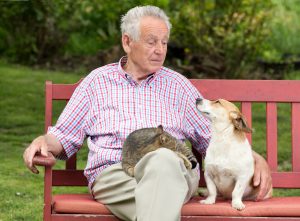
The love people have for their pets can be seen on the calendar, from National Love Your Pet Day in February, to National Pet Day in September, to World Animal Day in October. So, what do we do when a beloved pet dies? How do we celebrate the life that gave unconditional love?
STATS ON PET OWNERS
Every other year, the National Pet Owners Survey provides valuable information for pet owners and supporting industries.
The 2020-2021 survey gathered approximately 15,000 responses, and covered dogs, cats, birds, small animals, reptiles, freshwater fish, saltwater fish, and horses and, for the first time, chickens.
Here are a few of their findings:
- About 67 percent of households in the U.S. have at least one pet.
- More than 63 million American households own at least one dog.
- More than 42 million American households own at least one cat.
- There are 94 million cats and 89 million dogs in American households. I’m guessing that’s because more households are likely to have multiple cats than multiple dogs,
- As for the most abundant household pet… Can you guess? Fish. The National Pet Owners Survey says there are nearly 160 million of them in glass bowls and tanks across the country.
- And here’s the last statistic I want to share, again, from The National Pet Owners 2019 survey: Americans spent more than $75 billion on their pets in 2019. That number includes food, supplies, medicines, veterinary care, live animal purchases and grooming and boarding.
It’s clear. The love owners have for their pets is real. And that’s what makes the death of a pet so hard.
LINKEDIN POLL
A few weeks ago, I posted a poll on LinkedIn. One simple question: If you had a pet that died, did you have some kind of funeral? In hindsight, I should have offered better options. That said, here are the results:
30% Yes, and I’m glad I did.
20% No, it was too much trouble.
0% No, and I regret it.
50% Other – They responded with their own words.
Some people emailed me to answer the question or to add details to their response on the survey. I am grateful beyond measure because it is in these personal responses that we see a heart-opening aspect of our humanity. Here are a few examples:
Sandra said: I have lost two dogs and not had a ceremony. I prefer to remember my dogs in my own way privately. Losing a pet is heart wrenching and you just need to work through the grief your own way. Only pet owners understand the feeling you get when a pet dies.

The dachshund puts the head in hands of the owner.
As I told Sandra, she expressed what so many of us feel. My cat has been gone for 20 years and, to this day, when I pull out a certain chair at the dining room table, I remember how she liked to sleep there, tucked under the tablecloth.
Louise responded to the poll saying she didn’t have a ceremony of any kind because she simply didn’t think of having one.
I wasn’t surprised by her response. It’s only been in the last few years that I’ve noticed people having some kind of funeral ceremony when a pet dies. Not having a ceremony doesn’t mean people don’t grieve. It just means the concept of pet funerals hasn’t become part of our everyday world. I suspect that will change when pet lovers realize how helpful a ceremony can be for the healing process.
Mary wrote to tell me about her black-and-white tuxedo cat, Horatio, who had come to her as a stray. She said: I didn’t have a ceremony, per se, but I was very intentional about the burial, which felt like a personal ceremony. I dug the grave in a special place in the pasture, put rose petals in the bottom of the grave, wrapped my sweet Horatio in my flannel shirt. This is a shirt that Bruce would always get out and let Horatio snuggle with, whenever I had to be out state. So I tied the flannel shirtsleeves around him, like I was hugging him and laid him in the grave along with some of his favorite toys. We covered him with flowers before covering him with earth. We put larger stones on top of his grave and I hung a wind chime on a fence post just next to the grave. All of these things felt important, in honoring his life, and what he had meant to us.
I’m a member of the School of Podcasting. The founder, Dave Jackson, had a very vocal cat named Bernie who would sometimes walk into the studio when Dave was on the mic. We could all hear Bernie. And we could all hear how affectionately Dave talked to him. For those of us who had lost a pet, hearing Dave talk to Bernie brought back good memories of our own. So when Bernie died, we understood Dave’s grief. We felt it, too.
Fortunately, help is available.
PET LOSS SUPPORT GROUPS
Until recently, I didn’t know about the Association for Pet Loss and Bereavement, APLB for short. On their website, they describe themselves as “a nonprofit association of concerned volunteers who are experienced and knowledgeable in the tender subject of pet death.”

Mother Comforting Girl As Vet Treats Sick Dog
They recognize that a lot of people don’t have their own support system for sharing the grief that comes from the death of a pet. So APLB offers free chatrooms. They are facilitated by specially trained pet bereavement counselors. You don’t need to be a member of the organization to participate. I don’t know of any other organization offering this kind of service.
Sometimes, pet parents continue to celebrate the life of a pet they’ve lost. Referring to her cat, my friend Leslie said, We keep the little cedar box with her ashes on the bookcase in the living room, so she can watch over us. Every night, when we’d sit on the couch and watch TV, she’d sit between us. So now I put her blanket between us, and when we go to bed, we say, “Nighty night, little Punkin,” which we always did so she’d know it was lights out time. Silly, but comforting.
Sometimes, grief can blindside. David Hooper from Build a Big Podcast told me how heart-wrenching it was to have his dog put down. Weeks later, when he felt he was managing his grief, he came home from a stressful day at work, immediately went to put food in his dog’s bowl and reality hit. He sat down and cried. I’ve been there. My guess is you’ve been there, too.
MORE THAN PERSONAL PETS
Of course, many of us have feelings for animals that are not personal pets. I live on the East Coast. We hear about a beached whale and newspapers have photos and human interest stories of the people who rush to the shore to help save one of these giants of the ocean.
Every winter, we see videos about deer that have fallen into a frozen lake. We watch the humans and their heroic efforts to save the deer. We feel relief and joy when the animal is pulled to safety, warmed up, and released.
Last year in Australia when uncontrollable fires destroyed the habitat of koala bears, we watched wildlife rehabilitators bind the burned feet of the cuddly animals we’ve come to associate with gentleness.
Here in the United States, parts of California and Oregon have been on fire for over a week even as hurricanes ravage the coast. Right now, the volunteer responders who work with the organization RedRover.org are providing an emergency safety net for animals displaced by the fires in our western states.
The ASPCA (American Society for the Prevention of Cruelty to Animals) set up temporary pop-up shelters for animals when families must be evacuated from their homes and go to shelters. When the fire, or hurricane, or flood has passed, people work to reunite the animals with their families. We’ve all seen the videos. And we’ve heard the heart-breaking stories when families never show up to claim their pets.
Some of those stories have happy endings. My friend Carol adopted an unclaimed dog that had been rescued in a hurricane. Now, Sam (that’s what she named him) lives in a home that’s filled with love and takes Carol for walks every day.
There are organizations that work to prevent extinction. The World Wildlife Fund maintains a species directory of animals in danger of extinction.
For instance, sea turtles are endangered. They help maintain the health of the seagrass beds and coral reefs. Fortunately, the World Wildlife Fund is working with Arizona State University to create fishing nets that have solar powered LED lights that will deter the turtle.
It’s no surprise that there is an international World Animal Day. It was organized by writer and activist Heinrich Zimmermann in Germany back in March of 1925, nearly 100 years ago. The date has since been changed to October 4 to coincide with the feast of St. Francis of Assisi, a Catholic saint known for his love of animals. The day was organized to start a movement to prevent animal cruelty.
Today, when people ask the organization what they can do to help, the answers are simple:
- Be kind to animals.
- Visit a local animal shelter and check out the volunteer opportunities.
- Adopt a pet instead of buying one.
- Donate to a program that helps animals in need.
- Spread the word. The organization also has a video you’re invited to share.
PET FUNERALS
For many children, their first experience with death comes when a pet dies. We’ve all heard the stories of the parent who provides a shoe box lined with an old towel, digs a hole in the backyard, and holds the child’s hand as they say good-bye to the pet they loved. Just like the funerals we hold for humans, saying good-bye helps the healing begin.
According to an article earlier this year from Death Care Industry, over 11 million dogs and cats die in the United States every year. Because of the close bond people have with their pets, the people are often referred to as “pet parents.”
According to the International Association of Pet Cemeteries, the industry’s trade organization, there are approximately 700 pet cemeteries in the United States. In a November 2017 article for the Chicago Tribune, journalist Christopher Borrelli writes about pet cemeteries. One of the people he interviewed was Linda Peterson, niece of Patricia Blosser who founded Paw Print Gardens in 1970. Since then, more than 5,000 animals have been buried there. Peterson said that in the early days, burials were held at night because “clients were too ashamed to be seen treating an animal that well.”
That was 50 years ago. A lot has changed. A quick search on the Internet will yield lots of readings for pet funerals. Companies offer caskets and urns for pets. Artists will paint a portrait of a pet from a photo.
If you’ve been asked to lead a funeral ceremony for a pet, here is an outline you can follow:
- Welcome everyone to the service. Say a few words about what you’ve heard about the deceased pet.
- Invite three people who were close to the pet to share a story. Sometimes, it’s easier for a grieving pet owner to tell a story if there’s a prop available. If that’s the case, you can set up a pet altar. Have the pet’s family gather favorite toys, a leash, a food bowl, a box of treats, photos, and place them on a table.
Someone could talk about how the pet came to the family and how the pet was named.
Someone else could share a story about what life was like during the good years. If there are children in the family, say something about the relationship the children had with the pet. If the pet was a therapy dog, be sure to talk about how the dog made a difference to many people who were suffering.
The third person could talk about what it was like when the humans in the family could see that something had changed, that age was taking its toll, that their beloved pet was in pain, that a decision had to be made.
Talking about the final moments may be very hard for the person who shares that story. Don’t avoid it. Acknowledging the pain helps the healing begin. If you, as the one leading the service, have to tell that part of the story, do so.
- Sound can play an important role in the service. After the stories have been shared, you can ring tingsha (tin-sha) — two small cymbals joined by a short, leather cord. Or ring bells or chimes. You can strike a singing bowl. You can lead the guests in chanting Om. The chant is said to raise a person’s energy and calm the mind. The idea is to use sound to signal that you’re near the end of the service.
- If a coffin or urn is present, nod to it. Affirm that the pet being honored is gone though never forgotten.
- Close with a meaningful quote. Here’s one of my favorites. It’s from Anatole France, a French poet born in the 1800s. He said, “Until one has loved an animal, a part of one’s soul remains unawakened.”
- If appropriate, remind everyone that donations of food, toys, bedding are being collected for a local animal shelter. Let them know where they can drop off their gifts.
- Thank everyone for coming.
If you’re doing a funeral by yourself for your pet:
- Create a pet altar. Hold each item, call on your memories.
- If you had a dog and would go for walks together, put several items from the altar in your pocket and do a walking ritual.
- Or light a candle, sit quietly, and write in a journal.
- Or play music, close your eyes, and imagine your pet healthy and happy on the other side of the Rainbow Bridge. In fact, if you have children who are also grieving, encourage them to draw a rainbow bridge.
- Or, create a collage of photos.
- If you have the opportunity to bury at least some of the items from the altar with your pet, or with the ashes of your pet, do so.
If you’ve had to make the decision to have your pet euthanized, tell your vet that you want to do a ritual during the transition. One of my Life-Cycle Celebrant colleagues, Anita Larson, was asked by a friend to create such a ceremony when her dog had to be put down. Anita said yes. She knew a ritual would make the process more personal and less clinical. She wrote a beautiful ceremony, made copies for her friend, her friend’s children, and her boyfriend since they would all be present.
Anita also made a copy for the vet. You can imagine how meaningful the ceremony was for Anita’s friend. What might surprise you was how meaningful the ceremony was for the vet who later hugged Anita, thanked her, and said she never gets to hear the stories about the animals and their human families.
THE POWER OF RITUAL
I think of ritual as a visible act performed with invisible intent. In all the pet funeral rituals I’ve mentioned, the visible actions are designed to begin the invisible intent of healing.
For someone who hasn’t experienced the power of a good ritual, she might ask, What’s the big deal? Simply put, rituals reveal the invisible dimension of life. In that dimension is where we can connect with the deepest part of ourselves and with the energy some call the Universe, the Divine, the Force, God, Mother Nature, chi. I see that dimension as the realm of all things spiritual. That’s where we can find meaning to who we are, what we do, and why we’re here. Ritual opens the door to that dimension.
Have you had a funeral or memorial for your pet? What did you do? How did it make you feel? I’m glad we now live in a world where no one need be “ashamed of treating an animal that well.”
For further exploration:
Anita Larson: ThinkOutsideTheCoffin.com
Association for Pet Loss and Bereavement: aplb.org
Red Rover: redrover.org
American Society for the Prevention of Cruelty to Animals: aspca.org
World Wildlife Fund (for directory of animals in danger of extinction): worldwildlife.org
International Association of Pet Cemeteries and Crematories: iaopc.com
American Pet Products (for surveys)

